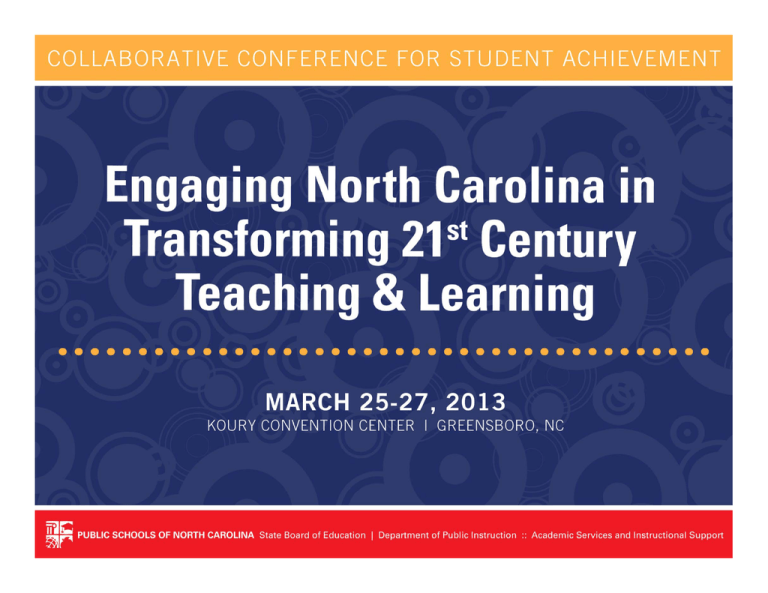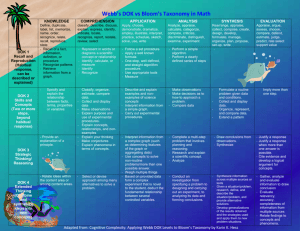Document 10823304
advertisement

Enter the Matrix
off
Cognitive
g
Rigor
g
Kim Case and Susan Barlow,
Instructional Facilitators
Caldwell County Schools
Collaborative Conference for
Student Achievement
March 2525-27, 2013
2
Essential Question
How does purposeful
alignment impact student
thinking and successful
performance?
3
L
Learning
i Targets
T
t
{ Recognize
the impact of
purposeful alignment on
student success
{ Synthesize
and apply
tools for meaningful
planning
4
3 R’
R’s off C
Content
t t Ali
Alignmentt
Rigor: Is
Ri
I the
th task
t k directly
di
tl aligned
li
d
to the standards?
{ Relevance: How do teachers
know all students understand the
purpose for the task?
{ Relationships:
p
How do teachers
know all students are comfortable
p
of the
with the final expectations
task?
{
5
Aligning
Rigorous
Tasks
Instruction
Assessment
Tools
Classroom Tasks
Standard FIRST
6
R l
Relevant
t tasks
t k …
require application of
knowledge, concepts, and
skills to real-world situations.
7
3R T
Task
kD
Design
i T
Toolkit
lkit
NC Standard Course of Study
(Common Core/Essential Standards)
Revised Bloom’s Taxonomy
Depth of Knowledge
Cognitive Rigor Matrix
8
North Carolina
St d d Course
Standard
C
off Study
St d
9
R i d Bloom’s
Revised
Bl
’ Dimensions
Di
i
Knowledge Dimensions
{ Factual
{ Conceptual
{ Procedural
{ Meta-Cognitive
Cognitive Processes
(Action Verbs)
{
{
{
{
{
{
Remember
Understand
Apply
Analyze
Evaluate
Create
From Anderson, Larin and David Krathwohl, A
Taxonomy for Learning, Teaching and Assessing. New
York : Longman, 2001.
10
Bl
Bloom’s
’ T
Taxonomy T
Table
bl
11
What is
Depth of Knowledge (DOK)?
A tool used to ensure that the
intent of the standard and the level
off student
t d t performance
f
matches
t h
the expectations of the assessment
A tool used to inform the level of
instruction needed for higher
student achievement
Vandeven, M. (2006, September 29). Depth of Knowledge(DOK). Retrieved from
Missouri Department of Elementary and Secondary Education:
http://www.dese.mo.gov/divimprove/sia/msip/DOK_presentation.pdf
12
Depth of Knowledge Levels
Webb, N.
Level 1
R
Recall
ll & R
Reproduction
d ti
Level 2
Skills & Concepts
Level 3
Strategic Thinking
Levell 4
E
Extended
d d Thi
Thinking
ki
13
DOK L
Levell 1
Facts
Recall &
R
Reproduction
d ti
Definitions
Examples:
Li ti
Listing
continents
ti
t
Identifying terms
Simple Tasks
14
DOK L
Levell 2
Decisions
D
i i
are made
d
beyond recall that may
require multi
multi-step
step
reasoning.
Skills and
Concepts
Examples:
{ Compare seasons
{ Summarize events
{ Classify items
{ Predict basic outcomes
using
g data
15
DOK L
Levell 3
Strategic Thinking & Reasoning
Evidence Supported Planning
{
{
{
Complex and abstract reasoning
Justified responses
S th i d iinformation
Synthesized
f
ti
within
ithi
one source
Examples:
• Analyze the impact of erosion
• Plan and conduct an
investigation
• Support mathematically
16
DOK L
Levell 4
Cognitive demand is
high and complex.
¤ Students are expected
to relate ideas within
content and develop
solutions or products.
Examples:
• Analyze author’s craft
• Interpret and organize information
from multiple sources
• Conduct a project that requires
data analysis, experiment design,
and results
17
Enter the
C
Cognitive
iti Rigor
Ri
Matrix
M ti
{
Integrates
Integ
ates Re
Revised
ised Bloom’s
Taxonomy and Webb’s DOK Levels
{
Utilized
l d ffor:
Analyzing instruction
z Influencing teacher lesson planning
z Designing and aligning assessment
items and instructional tasks
z
Hess,K., Carlock, D., Jones, B., and Walkup, J. (2009, June). “What exactly do
“fewer, clearer, and higher standards” really look like in the classroom? Using
a cognitive rigor matrix to ananlyze curriculum
curriculum, plan lessons,
lessons and implement a
ssessments”. Retrieved from Center for Assessment:
http://www.nciea.org/cgi- bin/pubspage.cgi?sortby=pub_date
Cognitive
g
Rigor
g Matrix
Karen Hess
Depth of
Knowledge
and
Revised Bloom’s
Taxonomy
DOK Level 1
Recall and
Reproduction
DOK Level 2
Basic Skills and
Concepts
DOK Level 3
Strategic Thinking
and Reasoning
DOK Level 4
Extended Thinking
Remember
Understand
Apply
Analyze
Evaluate
Create
19
“He who learns but does not
think is lost! He who thinks but
think,
does not learn is in great danger.”
-Confucious
20
M ki Thinking
Making
Thi ki Vi
Visible
ibl
Ron Ritchhart, Senior Research
Associate at Harvard Project Zero
21
TIME
TO
GET OUR
THINKERS
ROLLING!
22
Designing Thoughtful Tasks
1.
2.
3.
4.
Design one to three instructional
tasks.
Write one task
k per sticky-note.
k
Determine where the task(s) fall on
the
h Cognitive
C
ii
Rigor
i
Matrix.
i
Post the sticky-note on the
corresponding
di
chart.
h
23
P
Purposeful
f l Alignment
Ali
t
24
T
Teacher
h
Relationships
R l ti
hi
Does communication with students
support successful student
experiences?
{ Are the actions of the teacher
differentiated to support and guide
student success?
{ Does
D
classroom
l
‘talk’
‘t lk’ promote
t
student learning aligned with the
standards?
t d d ?
{
25
P
Purposeful
f l Alignment
Ali
t
26
Student
Relevant Application
What are students producing?
{ Are student products aligned to the
standards?
{ Are the student actions aligned to
success?
{ Do students find solutions to issues?
{ Are students connecting knowledge?
{
27
Evidence of Student Learning
{
Do students’
students products demonstrate
evidence of deep content
understanding and critical thinking?
Example
p Artifacts:
{ Student
Presentations
{ Student Responses and Questions
{ Student Products
{ Student Learning or Reflection Logs
{ Teachers’ Anecdotal Notes
28
Get Students Thinking . . .
“Children (and adults) think in
shallow ways not for lack of
ability to think more deeply but
b
because
th
they simply
i l d
do nott
notice the opportunity.”
pp
y
http://www.pz.harvard.edu/vt
29
30
To create a thoughtful classroom,
consider…
{ How
do tasks foster student
thinking?
{ How do the actions of the
t
teacher
h encourage
self-awareness in students?
{ How do students capture their
thoughts?
http://www.pz.harvard.edu/vt
31
{ How
do students interpret
content and offer creative ideas
to each other?
{ How do students justify thought
with evidence?
{ How do students participate in
‘debate’ opportunities?
http://www.pz.harvard.edu/vt
32
Pl with
Plan
ith P
Purpose!!
Plan for THINKING!
33
M
More
Information?
I f
ti ?
Susan Barlow, Instructional Facilitator
Caldwell County Schools,
Schools K-5
K 5 Schools
sbarlow@caldwellschools.com
Kim Case, Instructional Facilitator
Caldwell County Schools, K-8 Schools
kcase@caldwellschools.com
34
Sources
(in order of use in presentation)
www.LeaderEd.com
www.p21.org
Anderson, L., Krathwohl, D., Airasian, P., Cruikshank, K., Mayer, R., Pintrich, P., Raths, J., and
Wittrock,, M. (Eds)
(
) ((2001).
) A taxonomy
y for learning,
g, teaching,
g, and assessing:
g A revision of
Bloom’s taxonomy of educational objectives. New York: Addison Wesley Longman, Inc.
Hess,K., Carlock, D., Jones, B., and Walkup, J. (2009, June). “What exactly do “fewer, clearer, and
higher standards” really look like in the classroom? Using a cognitive rigor matrix to ananlyze
curriculum, plan lessons, and implement assessments
assessments”.. Retrieved from Center for Assessment:
http://www.nciea.org/cgi-bin/pubspage.cgi?sortby=pub_date
Vandeven, M. (2006, September 29). Depth of Knowledge(DOK). Retrieved from Missouri
Department of Elementary and Secondary Education:
http://www.dese.mo.gov/divimprove/sia/msip/DOK presentation.pdf
http://www.dese.mo.gov/divimprove/sia/msip/DOK_presentation.pdf
http://www.pz.harvard.edu/vt
“Why Thinking Matters in Schools” http://www.youtube.com/watch?v=XxKIa6Zr1NQ
35







